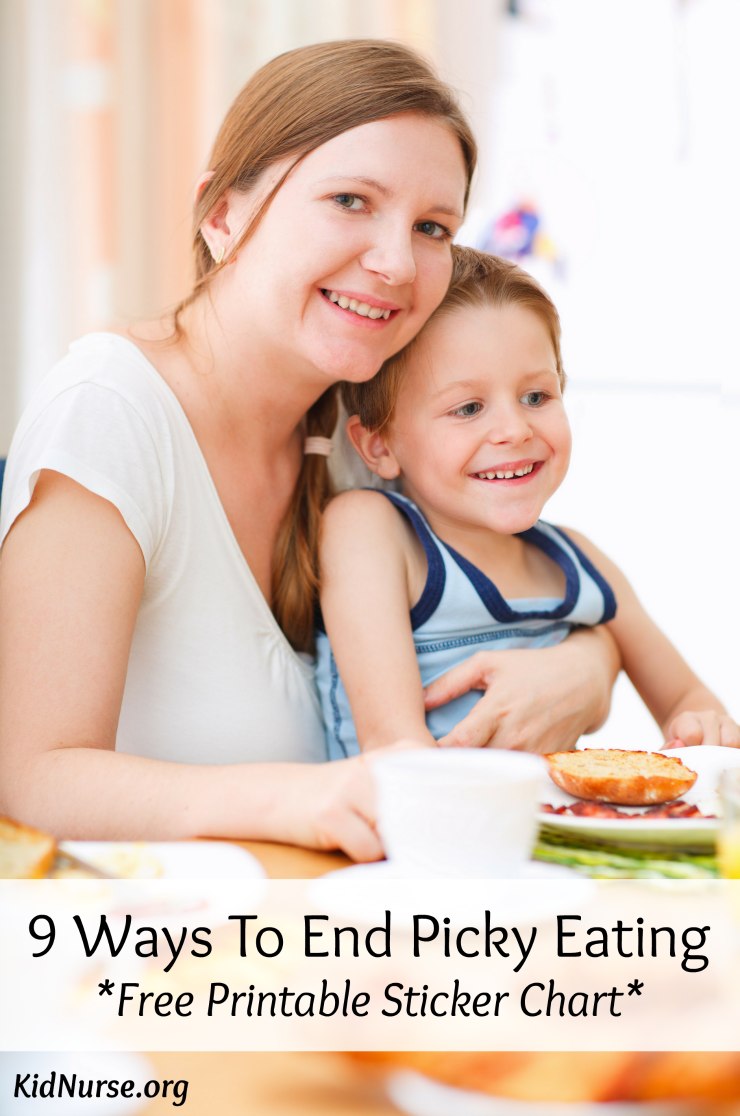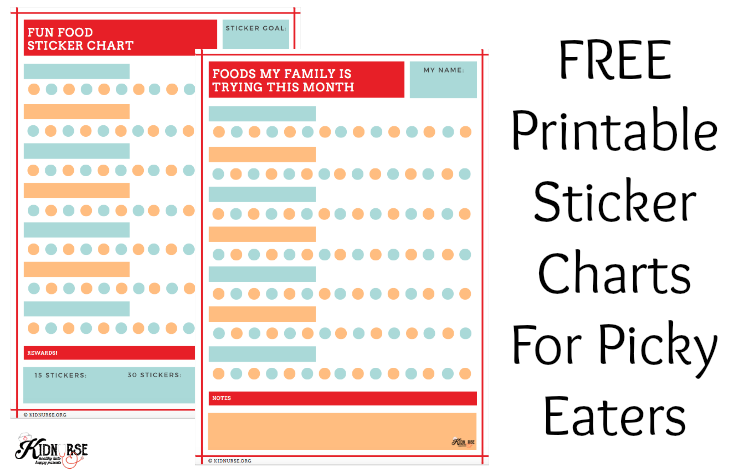To The Mom At Her Wit’s End With Picky Eaters
June 21, 2017
KidNurse Community Question: “I’m looking for advice on picky eaters. My children are three and four years old and refuse to try new things. They have a total of about 4 food items they will eat and turn up their noses at everything else. At what point should I tell them they have no choice but to eat what I put on their plate? I don’t like the idea of doing that, but they’re getting little to no nutritional value out of the foods they do eat.”

What Can I Do About Picky Eaters?
Picky eating is a massive problem facing parents today. One study found 50% of children between the ages of 19-24 months were picky eaters. That means that half of families with little ones will deal with picky eating at one point or another! I believe it, because I hear it all the time in my office, “Why won’t they eat? I feel like I’ve tried everything, and I’m giving up.” Unfortunately, this picky eating epidemic is making dinner a time-consuming affair with many mothers turning to painstakingly preparing different items for each of their picky eaters.
My dear friends, it is time to end the dinner war. You, mom, must win this battle. This is for your good, just as much as your child’s.
I know you are tired. Toddlers are exhausting little people. You are already working 24/7 to keep them alive. You’re a champion for even going the extra mile to cook a family meal in the first place! You are doing a great job. When it’s the end of the day, I know it is much easier to cave to their drastic, sorrowful, whining demands and whip out the chicken nugget dinos after they refuse to eat the food you prepared. We have all been there.
It takes so much energy to muster the “you need to eat what I made for you” speech. But even more than that, I know moms are worried about this: “If he refuses to try what I made, isn’t it better that he at least gets the chicken dinos? What if he starts losing weight? If he’s had next to nothing of nutritional value today, isn’t it better that he at least gets a few calories?”
No, not necessarily, dear friend.
Moms today have so many battles to face. Development, sleep, overcoming bad behaviors, education and enrichment, and of course, nutrition, just to name a few. It’s very overwhelming. Among all the new and ever-evolving challenges, I understand why tackling picky eating habits frequently and unintentionally falls towards the bottom of that to-do list.
But, I’m here to encourage you that we can’t let that happen. This is a battle you can win! Before tackling “how” to help our picky eaters, we have to be grounded in our why. I feel like so many of the parents I work with are forgetting why we fight for our children’s nutrition. Remember, almost every element of parenting takes consistency. Working with picky eaters is no exception. If we aren’t grounded in truly believing our why, we won’t be able to provide the follow-through to making healthy eating a habit. This is critically important, so here’s why we fight the healthy food fight…

Why You Need To End Picky Eating
Early eating habits are very important.
Developing healthy eating patterns as soon as possible is critically important. Evidence is even suggesting that an infant’s acceptance of solid food may be influenced by the food choices a mother makes during pregnancy. The first five years of your child’s life is a time of rapid physical growth and change. During this time, children learn to make food decisions, and it’s important to set them up with healthy food options from the get-go. We know that developing healthy eating patterns, or lack thereof, in childhood will impact your child’s health for the rest of their lives. Kindergarteners who were overweight were almost three times as likely (21%) as children of normal weight to become obese by the time they reached the eighth grade. This is very concerning considering that nearly 1 in 4 children ages 2 to 5 is already overweight or obese. What’s the take away? All the food we give our children early in life counts. Make it as healthy as possible, as soon as possible.
Feeding picky eaters isn’t just about consuming calories.
Food refusal and picky eating in toddlers and preschoolers isn’t just about nutrition anymore, there are also psychological and family dynamics that we need to consider. We cater specific meals to babies because they need it. First breastmilk or formula, then a typical progression of baby food. That’s what infants developmentally need for their nutrition. Toddlers and preschoolers, however, don’t need food catering the way they did when they were babies. They need to transition to adult foods. This transition is a progression that happens at different times for each child, but I generally I think the sooner you make it, the better.
Developmentally, toddlers need a variety of highly nutritious food. Developmentally, it is also normal for many toddlers and preschoolers to be opposed to this. This combination is the root of picky eating. But, whether they know it or not, toddlers need nutrition from a variety of healthy sources more than they need nutritionally-depleted calories from the 4 or 5 foods they are willing to eat (have I mentioned that on any given day, American toddlers are more likely to eat French fries than vegetables?). Consuming nutritional-depleted calories just for the sake of getting them to “eat something!” isn’t the be-all, end-all goal.
Children don’t teach themselves how to eat healthy food.
I’m sorry to take away this hope, but truly, in my experience, I have never seen a child go from protesting healthy food one day to “please pass the green beans” the next. So, if you are caving to food demands with the precious hope that food maturity will suddenly one day just happen, please realize that day will only come if you intervene. I know one young man who ate chicken nuggets every day until he was 18 years old. Seriously. Left to their own devices, children very, very rarely make healthy food choices.
Eating is one of the most social experiences we have as humans.
Every holiday, every celebration, every playdate, every barbecue with the neighbors, every picnic, and almost every outing usually revolves around some element of eating with family or friends. Picky eating has serious implications for social events and activities. Whether you are constantly packing other food alternatives with the hope your child will eat it, or dealing with a meltdown at the event if there isn’t a food your child will eat, picky eating will bleed over into most elements of your social life. It is sad to me that many families with picky eaters have unknowingly adjusted to this as their reality, but feeding your picky eater shouldn’t have this massive social impact. If it does, something has got to give (hint: and it’s not you, mama).
Peace at mealtime is a nonnegotiable.
If you only eat one meal a day with your child until he or she is 18, (let’s use dinner as an example), you will have consumed 6,570 dinners together. We aren’t going to let the next 6,000+ dinner experiences you have with your child be dictated by the 5 foods he is willing to eat. We just won’t. You and your child deserve to have dinner time be a peaceful, bonding, incredibly powerful family experience.
Peace during dinner time is not a mythical unicorn. It can absolutely be a reality with you leading the charge. Picky eating, and the pleading, protesting, crying, and exhaustion that typically follow it, will rob you and your family of that amazing joy. Don’t miss out because you are nervous and tired at the thought of butting heads with your picky eaters. What you are sacrificing is not worth it. Now is the time to put in the hard work to create healthy habits that can last a lifetime.
It’s not just about stopping the eating behavior we don’t want. It’s about moving towards what’s best for our family. So, what do I want you to experience, moms? Food freedom. Food freedom starts by not being limited to serving your children 5 different foods without protest. It continues with the experience of being able to enjoy new foods, together, as a family. It embraces the virtue of moderation and balance. Food freedom has ample, guilt-free grace on the many days that will call for pizza delivery or cereal for dinner. Those days will always be a part of the rhythm of our busy lifestyles. But food freedom at its core also gives the peace of mind, that at least most days, your children are eating fruits and vegetables and meeting their nutritional needs (and this is the most important part) without battles. Putting an end to pick eating isn’t just about what we are running from, it’s about understanding the vision of freedom we need to be running towards.

How To End Picky Eating
There isn’t a magical solution that will work for every family immediately, but I do have some proven strategies you can try. Mix and match. Find out what works best for your family. Every child is a little different. But here’s the thing: keep trying. Keep being consistent. Stick to your why, and eventually, picking eating will become a problem of the past.
*While I think these strategies are helpful for all children, if your child has a BMI below the 10% or above the 90%, I would recommend consulting with your pediatric provider for more specific nutritional advise.
1. Let your children be part of the food process as much as possible. Take your children grocery shopping with you. Let them help pick out healthy foods. Allow them to help with age-appropriate cooking tasks when you are making dinner. Engagement in the entire process is an effective strategy to help picky eaters with acceptance of healthy foods.
2. Throw away junk food. If you don’t want your kids to eat it, don’t keep it in the house. This makes healthy eating simpler and more obtainable for everyone. Model healthy eating for your children.
3. You don’t have to tackle several new foods at once. It’s perfectly fine to incorporate a blend of new foods with foods you know your children already enjoy eating.
4. You don’t have to tackle picky eating at breakfast, lunch, and dinner all at the same time, either. Start by working on picky eating during dinner. Once you’ve accomplished that, giving healthy options at breakfast and lunch tend to be much easier and more quickly accepted.
5. Be careful with afternoon snacks. Children who just ate a short time ago are much less likely to have the hunger to compel them to try new foods at dinner. Also, snack time is a key time for fruits and veggies. I tend to think if they aren’t hungry enough to eat fruit or veggies at snack time, then they aren’t hungry.
6. The concept of “togetherness” at family dinner time is critical! Research has found this time and time again. To me, this doesn’t just mean being physically together. I think having the same food at the same time is what helps build relationship and bonding that is so important for children. Which means…
7. Stop making individual meals for every person at the table. Do your hardworking-self a huge favor and just stop. Mom, your sanity is a HIGH priority. Making one meal on a weeknight is hard enough. Making a meal for each individual family member could drive the best of us CRAZY. That is not a good long-term solution for moms or anyone (remember those 6000+ dinners? Yeah…).
8. Here’s an important one: Most research shows that it takes children about 10-15 times to try a new food before they want to eat it on their own accord (especially if they are 3 years or older). Yes, that means 10-15 times with EACH new food. This requires a lot of patience! One study found that 90% of parents offered kids food they did not like only 3-5 times before giving up. What does this mean? We need to change our expectations and be more persistent. Also, this is why the 1 (or 2 or 3…) bite rule HAS to exist. Even if it is a very small taste, you are still making progress. Don’t give up. For some kids, I think that sticker charts can be very helpful with actually tracking the amount of times your child has tried a new food. Visually, I think this is also helpful for parents. Let’s not get discouraged. Keep trying. At the end of this post, I have a free, printable sticker chart you can use for tracking the new foods you are working on as a family.
9. Children are really fast learners. They are sometimes really stubborn, too. If you have already tried repeatedly to incorporate family dinners, sticker charts, and are still constantly begging your children to eat what you make, feel no guilt, I repeat: no guilt, about ending dinner and sending kids to bed. I have not seen a food strike last for more than 3-4 dinners before your kids take the hint that you mean business. Mothers have been doing this for all of time, because it’s highly effective. Like I said, kids are smart and they learn fast!
Let’s also remember this, hunger can be a virtue. I think this is a little secret our parents and grandparents understood so much better than we do. In stark comparison to all of time and history, most of our little ones today have been blessed to never truly experience food scarcity. Instead, you have likely been providing daily meals and snacks on an every-3-hour rotation since the time they were born. Living with plenty is such a gift. How would a child know what hunger is if they’ve never come close to experiencing it? Sometimes, children don’t understand this gift fully without experiencing, even if only on a very limited basis, the alternative of going to bed a little hungry. Teaching this concept as a consequence that is brought about by your child’s own actions and choices (to not participate in the family meal), is not only important, but necessary for some children. We do not need to be fearful or ashamed of teaching our children gratitude.
With patience (and some hard work), you can take back your family dinner and put an end to picky eating. Stand strong. You’ve got this!
FREE Printable Sticker Chart For Picky Eaters
Click here to download your free printable sticker chart to help you and your picky eaters track how many times they have tried new foods. It’s a great motivation tool.

Click Here to Download your FREE chart!
Author: Dani Stringer, MSN, CPNP, PMHS – founder of KidNurse and MomNurse Academy